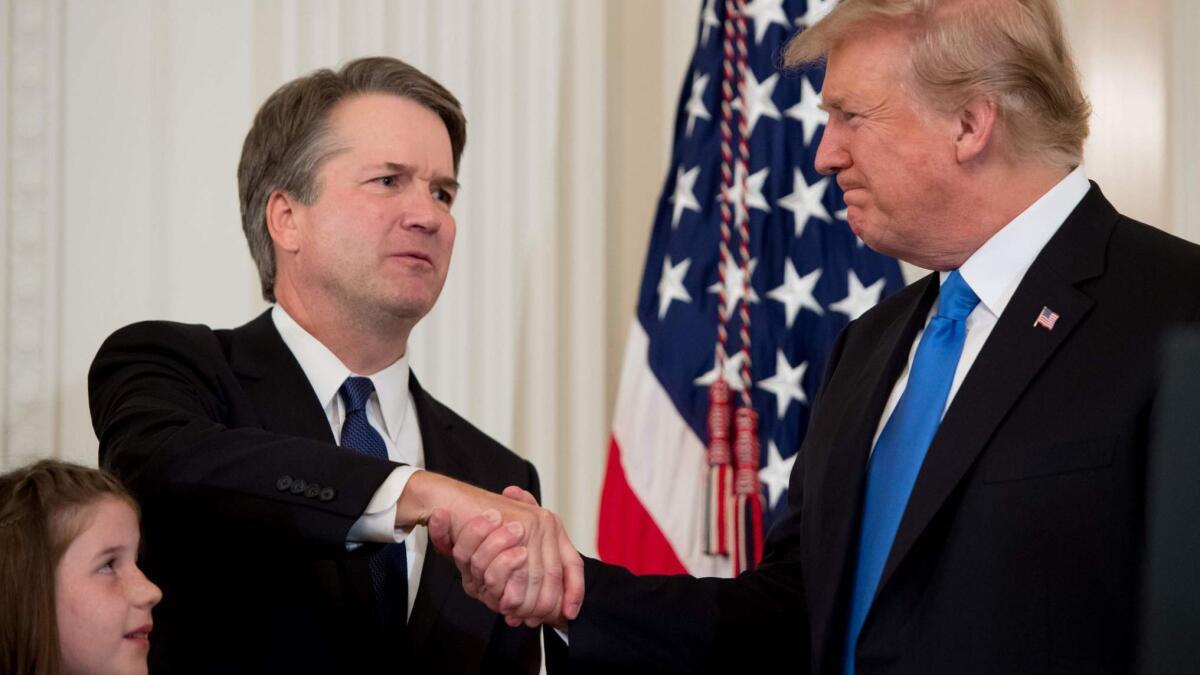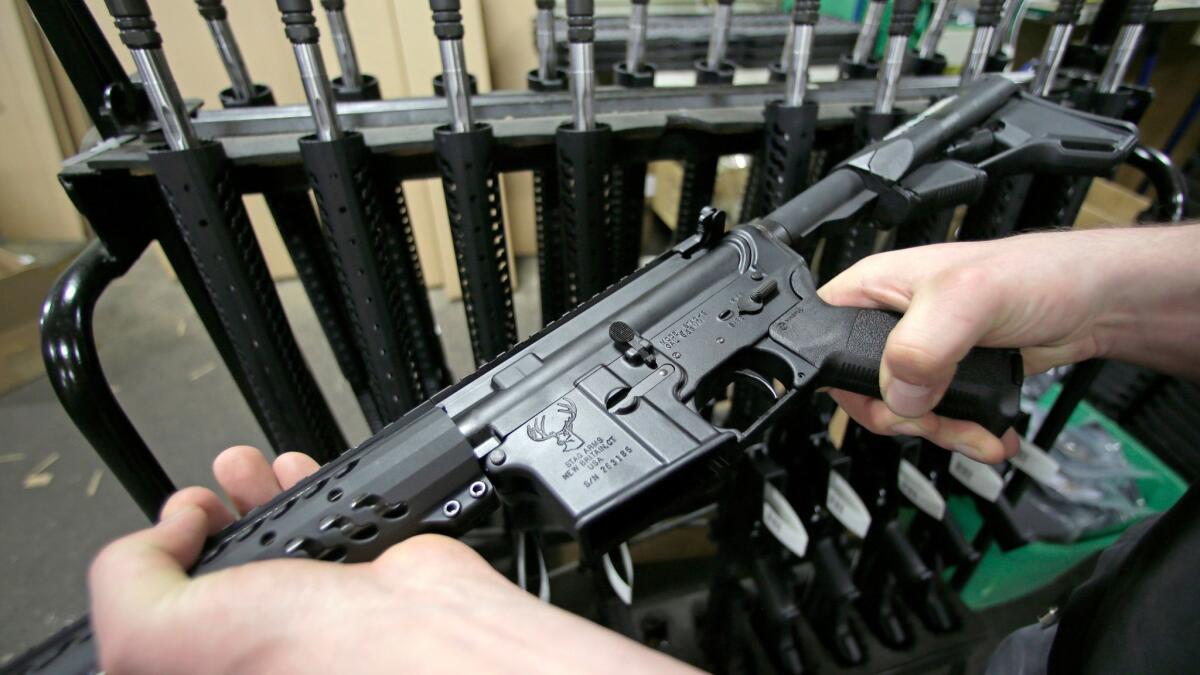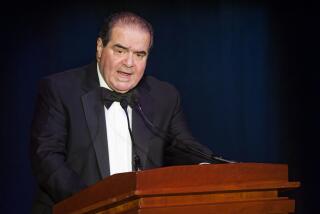Brett Kavanaugh, Trump’s Supreme Court pick, could have a major impact on gun laws, rejecting assault-weapon bans

Reporting from Washington — With the addition of Judge Brett Kavanaugh, the Supreme Court could have a conservative majority to strike down bans on semi-automatic weapons in California and other liberal states and to decree that law-abiding Americans have a right to carry a gun in public.
Although the fight over Kavanaugh’s nomination has mostly focused on abortion and healthcare, President Trump’s second nominee to the court could have a rapid impact on the national debate over gun control — a topic the high court repeatedly has avoided wading into in recent years.
The issue highlights a central difference between an earlier generation of legal conservatives, including many Reagan-era appointees, who emphasize judicial restraint, and today’s more activist conservatives who say they are enforcing the original meaning of the Constitution and are willing to use it to block liberal legislation from the states.
Kavanaugh’s record puts him in the activist group. In one notable dissent, for example, he argued the Constitution prohibits a state from banning so-called assault weapons.
A decade ago, the court, in a 5-4 opinion written by the late Justice Antonin Scalia, ruled that the 2nd Amendment protected the right of individuals to have a gun for self-defense. The decision struck down a District of Columbia law that prohibited residents from keeping a handgun at home. Two years later, the court in an opinion by Justice Samuel A. Alito Jr. struck down a similarly strict ban from Chicago.
Since then, however, the justices have refused to hear further cases on gun rights. It takes four votes to hear an appeal and five to issue a ruling. The court’s reticence on the issue indicated that Justice Anthony M. Kennedy, the usual swing vote, and perhaps Chief Justice John G. Roberts Jr., were not ready to go further and to strike down more regulations on firearms.
The court’s silence has not been for lack of opportunities. Gun-rights advocates have tried several times to overturn state restrictions on the sale of rapid-fire rifles and on carrying concealed guns. They argue that those types of gun control measures violate the 2nd Amendment.
They have repeatedly lost in the lower courts, and so far, the high court has refused to hear their appeals — despite strong dissents from Justices Clarence Thomas and Scalia and by Justice Neil M. Gorsuch after he replaced Scalia on the court.
In the last three years, the justices let stand rulings that upheld bans on rapid-fire guns in Connecticut, New York and Maryland as well as the Chicago suburb of Highland Park. Last year, they disappointed gun-rights lawyers in California when they turned away a challenge to the state law that sharply limits who may carry a gun in public.
“The right to bear arms extends to public carry,” Thomas and Gorsuch said in dissent.
If Kavanaugh joins the court this fall, replacing Kennedy, he will add a vote on the conservative side. It will then be left to Roberts to decide how far to go.
The 2nd Amendment, adopted in 1791, says: “A well-regulated militia, being necessary to the security of a free state, the right of the people to keep and bear arms, shall not be infringed.” Through most of its history, until Scalia’s decision in 2008, the Supreme Court had little to say about it, except to suggest the amendment dealt mostly with militias and weapons that could be useful in military service.
A ban on a class of arms is not an incidental regulation. It is equivalent to a ban on a category of speech.
— Brett Kavanaugh, 2011
Kavanaugh, in his current job as a judge on the D.C. Circuit Court of Appeals, has staked out an unusually strong stand in favor of what the 2nd Amendment means, writing in favor of broad gun rights.
He wrote a 52-page dissent when a three-judge appeals court panel, with two other Republican appointees forming the majority, upheld a District of Columbia ordinance that prohibited “assault weapons” and magazines with more than 10 rounds of ammunition.
He argued that the right to bear arms outlined in the 2nd Amendment should be interpreted like the right to freedom of speech laid out in the 1st Amendment, with only narrow set of circumstances in which a state can limit an individual’s right.
“A ban on a class of arms is not an incidental regulation. It is equivalent to a ban on a category of speech,” he wrote in Heller vs. District of Columbia in 2011.
Defenders of the District of Columbia law said the measure would protect the police and prevent mass shootings. Kavanaugh said judges should not weigh the benefits of gun-control laws.
“As a citizen, I certainly share the goal of Police Chief Cathy Lanier to reduce and hopefully eliminate the senseless violence that has persisted for too long and harmed so many...,” he wrote, “but our task is to apply the Constitution.”
He wrote: “Gun bans and gun regulations that are not longstanding or sufficiently rooted in the text, history and tradition are not consistent with the Second Amendment individual right.”
He concluded that because rapid-fire weapons are “in common use today” and “have not been traditionally banned,” they are fully protected under the 2nd Amendment. “Although a few states and municipalities ban some categories of semi-automatic rifles, most of the country does not,” he added.
That expansive view of gun rights and the willingness to strike down gun control measures adopted by legislative bodies contrasts sharply with many in the earlier generation of judicial conservatives, who emphasized the limits on judicial power.

Three years ago, for example, Judge Frank Easterbrook, a prominent Reagan appointee to the U.S. Court of Appeals for the 7th Circuit in Chicago, wrote the decision upholding Highland Park, Ill.’s ban on rapid-fire guns and large-capacity magazines. He said judges should be reluctant to second-guess communities on how to protect the public’s safety.
“Assault weapons with large-capacity magazines can fire more shots, faster and thus can be more dangerous in the aggregate. Why else are they the weapons of choice in mass shootings?” he wrote.
“The best way to evaluate the relation among assault weapons, crime and self defense is through the political process,” not by judicial rulings, he wrote. “The central role of representative democracy is no less a part of the Constitution than is the Second Amendment.”
Similarly, Judge Douglas Ginsburg, another Reagan appointee, wrote the opinion upholding Washington, D.C.’s ban on assault weapons, which prompted Kavanaugh’s lengthy dissent.
Ginsburg said a ban on rapid-fire guns does not “disarm individuals or substantially affect their ability to defend themselves,” while “large capacity magazines pose a danger to innocent people and particularly to police officers.” The District of Columbia Council was within its rights to decide those public-safety benefits outweighed the burden on individuals who wanted to own such weapons, he wrote.
UCLA law professor Adam Winkler said Kavanaugh’s opinion “reflects an unusually broad view” of gun rights.
“He said judges should not consider public safety. And he says only long-standing gun laws are permissible. If so, what about new and innovative regulations?” he asked, such as laws that deny gun rights to people convicted of domestic violence.
Kavanaugh’s views on the issue have attracted notice from both sides of the gun control debate.
Shortly after Trump announced the nomination, the National Rifle Assn. called Kavanaugh “an outstanding choice” and said the Senate should swiftly confirm him.
“Judge Kavanaugh has demonstrated his clear belief that the Constitution should be applied as the Framers intended. … He will protect our right to keep and bear arms,” said Chris W. Cox, the NRA’s chief lobbyist.
Former Rep. Gabrielle Giffords, who survived a 2011 mass shooting that left six dead, said in a statement that Kavanaugh’s “dangerous views on the Second Amendment are far outside the mainstream of even conservative thought and stand in direct opposition to the values and priorities of the vast majority of Americans.”
“It’s pretty scary for those of us who care about sensible gun regulations,” said Avery Gardiner, co-president of the Brady Campaign to Prevent Gun Violence. She said she was concerned about the legal drive to extend the right to carry guns in public.
“There is a big push for the right to carry a loaded gun every minute of the day,” she said.
More stories from David G. Savage »
Twitter: DavidGSavage
More to Read
Get the L.A. Times Politics newsletter
Deeply reported insights into legislation, politics and policy from Sacramento, Washington and beyond. In your inbox three times per week.
You may occasionally receive promotional content from the Los Angeles Times.











